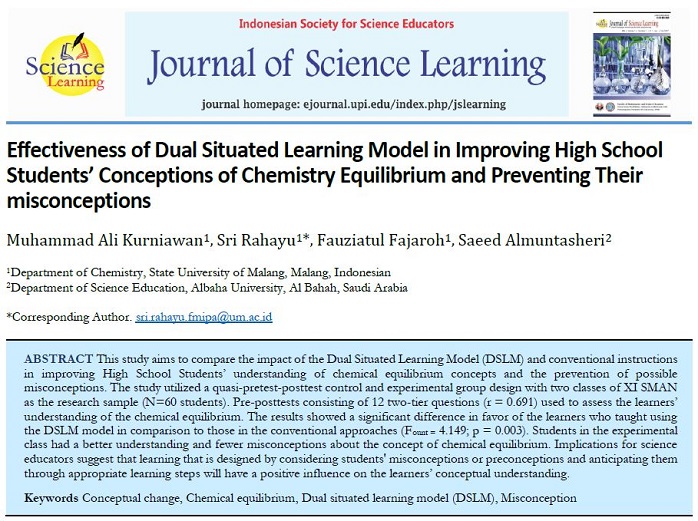
Effectiveness of Dual Situated Learning Model in Improving High School Students’ Conceptions of Chemistry Equilibrium and Preventing Their misconceptions
Abstract
Full Text:
Download PDFReferences
Atasoy, B., Akkus, H., & Kadayifci, H. (2009). The effect of a conceptual change approach on understanding of students’ chemical equilibrium concepts. Research in Science & Technological Education, 27(3), 267–282.
Banerjee, A. C. (1991). Misconceptions of students and teachers in chemical equilibrium. International Journal of Science Education, 13(4), 487–494.
Bilim, E. (2003). Student’s Misconceptions on the Concept of Chemical Equilibrium Öğrencilerin Kimyasal Denge Konusundaki Kavram Yanılgıları. Education, 28(127), 10-17.
Çalik, M., Kolomuç, A., & Karagölge, Z. (2010). The effect of conceptual change pedagogy on students’ conceptions of rate of reaction. Journal of Science Education and Technology, 19(5), 422–433.
OECD. (2015). OECD family database. OECD Paris. http://www.oecd.org/social/family/database.htm
Demircioglu, G., Ayas, A., & Demircioglu, H. (2005). Conceptual change achieved through a new teaching program on acids and bases. Chemistry Education Research and Practice, 6(1), 36–51.
Demircioğlu, G., Demircioğlu, H., & Yadigaroglu, M. (2013). An investigation of chemistry student teachers’ understanding of chemical equilibrium. International Journal on New Trends in Education and Their Implications, 4(2), 192–199.
Hackling, M. W., & Garnett, P. J. (1985). Misconceptions of chemical equilibrium. The European Journal of Science Education, 7(2), 205-214.
Henikusniati -, Andayani, Y., & Savalas, L. R. T. (2015). Implementation of instruction using science process skills approaches for improving learning outcomes of Public Vocational School 3 Mataram. Jurnal Penelitian Pendidikan IPA, 1(2), 52-58.
Hewson, P. W. (1992). Conceptual change in science teaching and teacher education. A Meeting on “Research and Curriculum Development in Science Teaching,” under the Auspices of the National Center for Educational Research, Documentation, and Assessment, Ministry for Education and Science, Madrid, Spain. Retrieved from https://www.researchgate.net/profile/Peter_Hewson2/publication/253300170_Conceptual_change_in_science_teaching_and_teacher_education/links/571fe01308aeaced788acc6b/Conceptual-change-in-science-teaching-and-teacher-education.pdf.
Johnstone, A. H. (1991). Why is science difficult to learn? Things are seldom what they seem. Journal of Computer Assisted Learning, 7(2), 75–83.
Lotter, C., Harwood, W. S., & Bonner, J. J. (2007). The influence of core teaching conceptions on teachers’ use of inquiry teaching practices. Journal of Research in Science Teaching, 44(9), 1318–1347.
McDonald, C. V. (2013). An examination of preservice primary teachers’ written arguments in an open inquiry laboratory task. Science Education International, 24(3), 254–281.
Miao, Z., Reynolds, D., Harris, A., & Jones, M. (2015). Comparing performance: A cross-national investigation into the teaching of mathematics in primary classrooms in England and China. Asia Pacific Journal of Education, 35(3), 392–403.
Barke, H. D., Hazari, A., & Yitbarek, S. (2008). Misconceptions in chemistry: Addressing perceptions in chemical education. Springer Science & Business Media.
Nakhleh, M. B. (1992). Why some students don’t learn chemistry: Chemical misconceptions. Journal of Chemical Education, 69(3), 191.
Özmen, H. (2007). The effectiveness of conceptual change texts in remediating high school students’ alternative conceptions concerning chemical equilibrium. Asia Pacific Education Review, 8(3), 413–425.
Özmen, H. (2008). Determination of students’ alternative conceptions about chemical equilibrium: A review of research and the case of Turkey. Chem. Educ. Res. Pract., 9(3), 225–233.
Posner, G. J., Strike, K. A., Hewson, P. W., & Gertzog, W. A. (1982). Accommodation of a scientific conception: Toward a theory of conceptual change. Science Education, 66(2), 211–227.
Raviolo, A., & Garritz, A. (2009). Analogies in the teaching of chemical equilibrium: A synthesis/analysis of the literature. Chemistry Education Research and Practice, 10(1), 5–13.
Rosidah, Y. A. (2012). The use of the “Two-tier Test” to evaluate Grade 11 High School Students' understanding of chemical equilibrium in Batu. Retrieved from http://karya-ilmiah.um.ac.id/index.php/kimia/article/view /18349.
Sendur, G., & Toprak, M. (2013). The role of conceptual change texts to improve students’ understanding of alkenes. Chemistry Education Research and Practice, 14(4), 431–449.
Şendur, G., Toprak, M., & Pekmez, E. Ş. (2010). Analyzing of Students’ Misconceptions About Chemical Equilibrium. International Conference on New Trends in Education and Their Implications, 1-7.
Şendur, G., Toprak, M., & Pekmez, E. Ş. (2011). How Can Secondary School Students Perceive Chemical Equilibrium? Education Sciences, 6(2), 1512–1531.
She, H.-C. (2002). Concepts of a higher hierarchical level require more dual situated learning events for conceptual change: A study of air pressure and buoyancy. International Journal of Science Education, 24(9), 981–996.
She, H.-C. (2004a). Facilitating changes in ninth grade students’ understanding of dissolution and diffusion through DSLM instruction. Research in Science Education, 34(4), 503–525.
She, H.-C. (2004b). Fostering radical conceptual change through dual-situated learning model. Journal of Research in Science Teaching: The Official Journal of the National Association for Research in Science Teaching, 41(2), 142–164.
She, H.-C., & Lee, C.-Q. (2008). SCCR digital learning system for scientific conceptual change and scientific reasoning. Computers & Education, 51(2), 724–742.
She, H.-C., & Liao, Y.-W. (2010). Bridging scientific reasoning and conceptual change through adaptive web-based learning. Journal of Research in Science Teaching: The Official Journal of the National Association for Research in Science Teaching, 47(1), 91–119.
Silberberg, M. S., & Amateis, P. (2018). Chemistry: The molecular nature of matter and change: with advanced topics (8e [8th edition, revised]). McGraw-Hill Education.
Treagust, D. (1988). Development and use of diagnostic tests to evaluate students’ misconceptions in science. International Journal of Science Education - INT J SCI EDUC, 10, 159–169.
Üce, M., & Ceyhan, I. (2019). Misconception in Chemistry Education and Practices to Eliminate Them: Literature Analysis. Journal of Education and Training Studies, 7(3), 202–208.
Vosniadou, S., Pnevmatikos, D., & Makris, N. (2018). The role of executive function in the construction and employment of scientific and mathematical concepts that require conceptual change learning. Neuroeducation Journal, 5(2), 58–68.
Zarei, E. (2016). Misconception about Chemical Equilibrium and Some Suggestions for Their Reduction. Iranian Physical Chemistry Conference, 19, 77-80.
DOI: https://doi.org/10.17509/jsl.v3i2.22277
Refbacks
- There are currently no refbacks.
Copyright (c) 2020 Muhammad Ali Kurniawan, Sri Rahayu, Fauziatul Fajaroh, Saeed Almuntasheri

This work is licensed under a Creative Commons Attribution-ShareAlike 4.0 International License.


Jl. Dr. Setiabudhi 229 Bandung 40154, West Java, Indonesia











